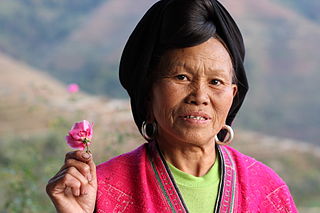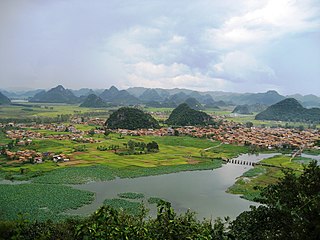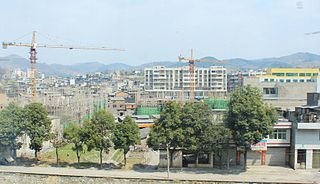
The Yao people is a government classification for various minorities in China and Vietnam. They are one of the 55 officially recognised ethnic minorities in China and reside in the mountainous terrain of the southwest and south. They also form one of the 54 ethnic groups officially recognised by Vietnam. In the last census in 2000, they numbered 2,637,421 in China and roughly 470,000 in Vietnam.
The Tujia language is a language spoken natively by the Tujia people in south-central China. It is unclassified within the Sino-Tibetan language family, due to pervasive influence from neighboring languages. There are two dialects, Northern and Southern. Both dialects are tonal languages with the tone contours of. The northern dialect has 21 initials, whereas the southern dialect has 26. As for the finals, the northern dialect has 25 and the southern 30, 12 of which are used exclusively in loanwords from Chinese. Its verbs make a distinction of active and passive voices. Its pronouns distinguish the singular and plural numbers along with the basic and possessive cases. As of 2005, the number of speakers was estimated at roughly 70,000 for the northern dialect, and 1,500 for the southern dialect, out of an ethnic population of 8 million.
The Hmu language, also known as Qiandong Miao, Central Miao, East Hmongic, or Black Miao, is a dialect cluster of Hmongic languages of China. The best studied dialect is that of Yǎnghāo (养蒿) village, Taijiang County, Guizhou Province, China.
Gelao is a dialect cluster of Kra languages in the Kra–Dai language family. It is spoken by the Gelao people in southern China and northern Vietnam. Despite an ethnic population of 580,000, only a few thousand still speak Gelao. Estimates run from 3,000 in China by Li in 1999, of which 500 are monolinguals, to 7,900 by Edmondson in 2008. Edmondson (2002) estimates that the three Gelao varieties of Vietnam have only about 350 speakers altogether.
Maojia is a mixed language in Southern China. Maojiahua is an unclassified Sinitic language that has undergone influence from Hmongic languages.
The Kam language, also known as Gam, or in Chinese, Dong or Tung-Chia, is a Kam–Sui language spoken by the Dong people. Ethnologue distinguishes three Kam varieties as separate but closely related languages.
The Kam–Sui languages are a branch of the Kra–Dai languages spoken by the Kam–Sui peoples. They are spoken mainly in eastern Guizhou, western Hunan, and northern Guangxi in southern China. Small pockets of Kam–Sui speakers are also found in northern Vietnam and Laos.

Huaning County is a county under the administration of Yuxi, in east-central Yunnan Province, China.

Qiubei County is under the administration of the Wenshan Zhuang and Miao Autonomous Prefecture, in southeast Yunnan province, China.
Bu-Nao, or Bunu proper, is a Hmongic (Miao) dialect cluster spoken in Guangxi, Yunnan, and Guizhou in China. Its speakers are among the Bunu : ethnic Yao (Mien) speakers of Miao languages.
Lalo is a Loloish language cluster spoken in western Yunnan, China by 300,000 speakers. Speakers are officially part of the Yi nationality, and Chinese linguists refer to it as "Western Yi" due to its distribution in western Yunnan. Lalo speakers are mostly located in southern Dali Prefecture, especially Weishan County, considered the traditional homeland of the Lalo. Historically, this area is the home of the Meng clan, who ruled the Nanzhao Kingdom (737–902 CE). Many speakers of Core Lalo dialects claim to be descendants of the Meng clan.

Gepo is a Loloish language of Yunnan, China spoken by 100,000 people. The speakers' autonym is, while the "-po" of "Gepo" means 'people'. It is spoken in 6 villages of Fumin County, eastern Luquan County, and other adjacent counties to the northeast.
The Xong language, is the northern-most Hmongic language, spoken in south-central China by ca 0.9 million people. It's called Xiangxi Miaoyu (湘西苗语), Western Hunan Miao, in Chinese. In Western sources, it's been called Eastern Miao, Meo, Red Miao and North Hmongic. The official alphabet was adopted in 1956.
The West Hmongic languages, also known as Chuanqiandian Miao and Western Miao, is the major branch of the Hmongic languages of China and Southeast Asia.
Cao Miao is a variety of Dong (Kam) according to Shi Lin (2012). Dialects include Liushi ("Sixty") Miao 六十苗, Sishi ("Forty") Miao 四十苗, and Ershi ("Twenty") Miao 二十苗. The Flowery Miao 花苗 do not consider themselves to be Cao Miao 草苗, although their language is similar to Sixty Miao and Forty Miao.
Pa Na is a Hmongic language spoken by about 1,000 people in Shangpai 上排, Zhongpai 中排, and Xiapai 下排 of Chengbu County, and Huangshuangping 黄双坪, Suining County in Hunan, China. It is also called "Red Miao." Yoshihisa Taguchi (2012) considers Pa Na to be most closely related to She and Jiongnai.
Raojia is a Hmongic language spoken by about 5,000 people in 3 villages of Heba Township 河坝乡, Majiang County, Guizhou.

The Longjia are an unofficially recognized ethnic group of western Guizhou province, China. They are officially classified as Bai by the Chinese government.
Nuoxi Yao, or Nuoxihua 𦰡溪话, is a Kam–Sui language of Nuoxi Township 𦰡溪瑶族乡, Dongkou County, Hunan Province, China. Even though they are classified as ethnic Yao people by the Chinese government, the Nuoxi Yao speak a Kam–Sui language closely related to Dong. Shi (2015:132) considers Nuoxi Yao to have split off from Dong about 600 years.






